:: 2017 :: 90cm x 30cm :: Acrylics, Inks, Markers and Coca Mambe on Canvas ::
My first steps on the caminito de coca, the little road of coca, took place on the first night of the retreat, in which a Huitoto elder named Isaias (Huitoto name Jiillero Nyakuto) held a Word of Life ceremony with tobacco and a preparation of coca called mambe. It was a long-held wish of mine to attend such a beautiful ceremony: he spoke of good behaviour, of the value of seeking connections with spirits and nature, and of the moral conduct a good person should aim for. Throughout we were given coca leaves to chew or a little mambe to savour, and late in the night, when the ceremony was done, I went to bed and noticed I was experiencing very delicate but fascinating visuals.
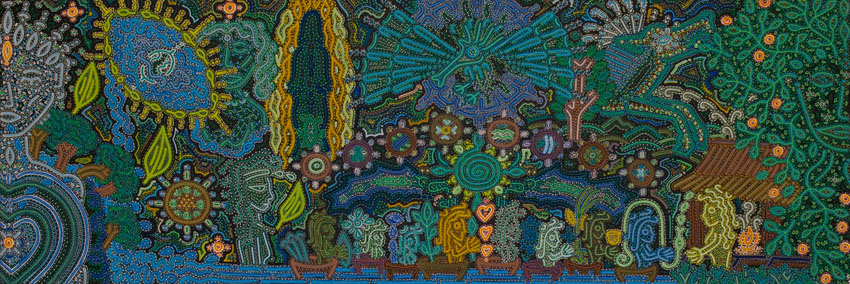
This was my first coca vision, of a beautiful horse with a wildly shimmering mane galloping through the hills and trees around the Eco-Lodge. Over successive nights I saw further images: the second night I saw a beautiful but strange hybrid creature: part-dragonfly, part-hummingbird, part-sea-horse, shimmering electrically before my eyes as I lay in the darkness. The third vision took place a couple of nights later during a very beautiful cacao ceremony in which we gathered together and sung songs from around the world.
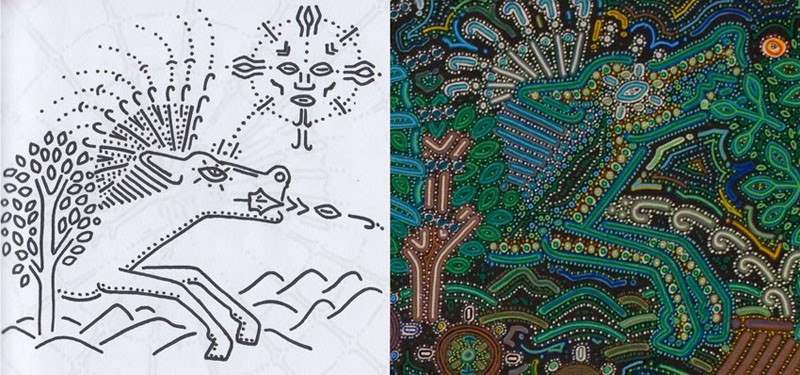
During the ceremony, I had mistaken the very strong Huitoto tobacco mixture for raw cacao, both of which were being passed around the group, and finding my mouth filled with bitter tobacco, I began to hiccup and cough and I thought I might be sick. One of the Muisca musicians named Johnny saw my situation and gave my a large handful of coca leaves to chew to solve the problem. And indeed it did - my coughing and hiccuping stopped, and the hot, sharp bitterness of the tobacco was replaced with the delightful sweetness of the coca leaves. As the ceremony progressed, I closed my eyes and I began to see some beautiful visual images, most strikingly, a golden-green woman with leaves for hair stretching out towards the sky. I gazed at this image, trying to remember the details, as I felt it was important.
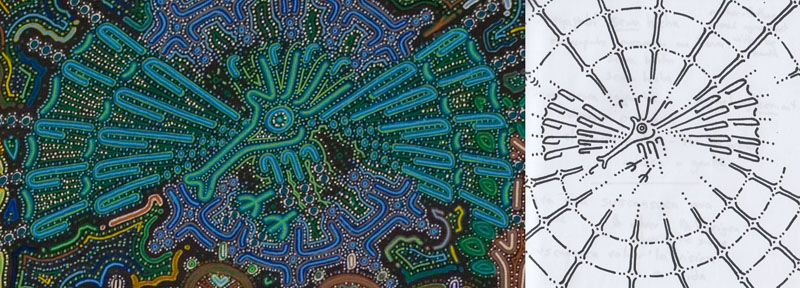
When I was drawing this third vision the next morning, two Muisca and Wiwa elders saw me sketching and suggested that this might be the madre de ayu, the mother of the coca tree. Wiwa elder Auimaku even took my pen and wrote the word Mebeakún next to my sketch. I wanted to stay modest here – it seemed hardly likely that I should meet the mother of the plant after such a short time, but Muisca elder Dwe Wiby explained that this vision could have been both a woman and the madre at the same time. Just as the coca tree bears seeds, so the madre is reflected in each woman. He seemed to be saying that I could see her both ways, as a woman of coca and as a vision of the madre de ayu herself. It was this conversation that began the image of the coca vision as a coca seed...
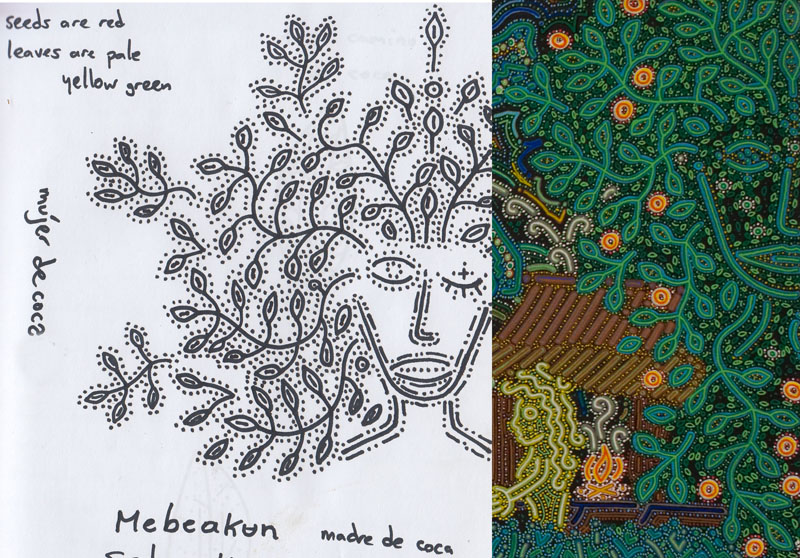
This left me very humbled, and increasingly grateful for the delightful gifts that this plant was giving me. I was truly touched, and I turned down the chance of attending a peyote ceremony – something I have wanted to do for many years – in order to keep walking this little road, this caminito, that the forest and the coca had opened up for me.
The fourth vision was the fullest vision of all. At first I saw a glowing golden galaxy, but it resolved itself into the Earth surrounded by water. The words las aguas del mundo appeared in my mind: ‘the waters of the world’. I caught sight of a little flow falling away and I followed it: it became a torrent and turned into a waterfall rushing over rocks and wending its way through trees until it became a fast flowing river. Floating along this river were eight semi-circular boats, shaped like traditional cacao-serving cups, but in my mind they were coca seeds.
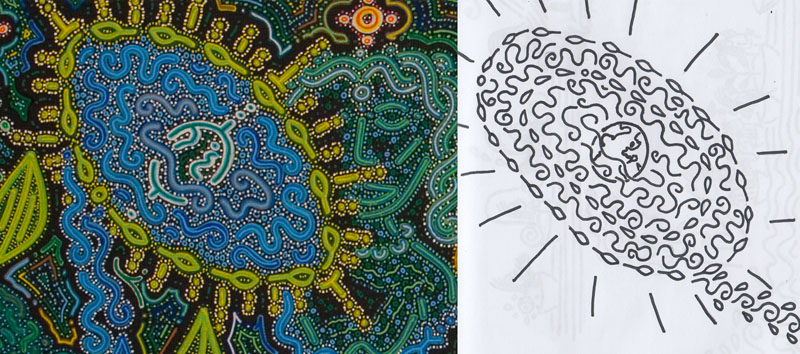
In the prow of each seed-boat stood a woman, alert and gazing forwards, and in each of their hands, the women brought gifts for humanity from the forest, and from the coca tree. The first woman brought the skills of hunting, while the second bore flowers for beauty, and the third brought sorrow and compassion. Next came the coca plant itself while the fifth woman carried love. The final three women carried the moon, representing the inner light of vision, corn for food and farming, and finally a beautiful serpent standing for sacredness itself. These gifts were brought to a ninth woman waiting at a maloca longhouse whose fire burned brightly. But I didn’t enter the maloca: rather I plunged into the water and beheld the coca boat-seeds from underneath, seeing that each one had a characteristic pattern on its underside.
I was stunned by this vision. Though it was delicate and I had to remain focussed to hold it, I felt as if the madre de ayu had somehow recognised my sacrifice, letting go of my desire – the peyote ceremony – in order to continue walking this coca caminito. I felt a sense of communication between myself and the plant that I haven’t truly felt since my years of working with salvia divinorum.
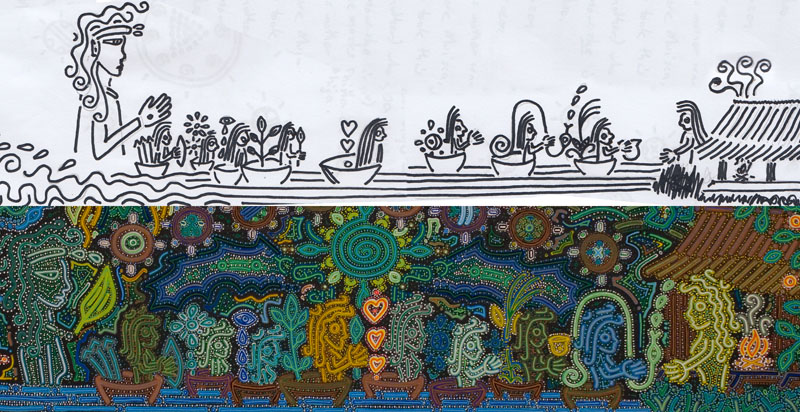
On my penultimate evening in the Eco-Lodge, I sought a fifth vision. By now I had already decided I would create an artwork of these visionary gifts from the coca mother and so I admit I had some expectations this time. However in this vision I was shown a series of unconnected images: a half-hidden leafy woman, a shadowy woman surrounded by bright flames, a Tairona bat-shaman, a swirling green labyrinth and a smiling coca leaf with its characteristic three lines – tres caminos as Muisca elder Dwe Wiby put it. As I began to wonder why I was seeing these unconnected images, I felt the arrival of a new thought: Well, I already showed you your big vision last time. Now I’m just giving you some beautiful images for your painting. At this, I smiled widely and understood, let go all of my expectations and attended closely to what I had already been shown, so that I could render it as beautifully as possible in artistic, visionary form.
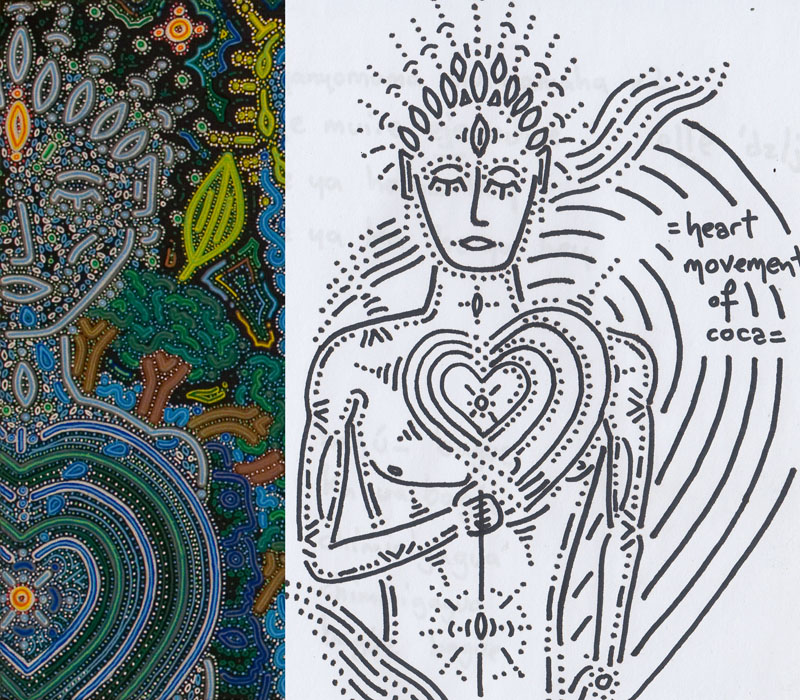
I don’t know of anyone else who has experienced gentle visions like this with coca, but the indigenous elders didn’t seem that surprised. Perhaps it’s quite common but they choose not to say much about it. Either way, it was a sublime surprise which animated and enlivened my ten days in the Sierra Nevada de Santa Marta with a whispering, shimmering sacred intent. It also left me feeling very strange about the world’s obsession with cocaine, a drug I have never liked. It is as if they have torn out the spirit of the tree in order to get the drug. I am so grateful to have seen these visions, these seeds from the coca mother. I am so grateful to have seen something of the natural truth of this plant teacher.
The title of this artwork is a composite of terms from five languages:
Ayuzule – a-yu-zhu-leh – This is the Kogi word for ‘coca seeds’, and was given to me by Leandro, a visitor to our gathering and exhibition on our last day in the Sierra Nevada de Santa Marta.
Mebeakún – meh-veh-a-kun – This is the word that Wiwa elder Auimaku spoke on seeing me drawing the sketch of the woman with leaves for hair from my third vision, and which he wrote next to the sketch. It means ‘mother of the coca tree’ in the Wiwa language.
Uba Ayu – u-bah-a-yu – Muisca elder Dwe Wiby gave me this phrase in the Muisca language when he was explaining about the coca tree and the seeds. Figuratively, it means ‘seeds of coca’, but it literally translates as ‘child of coca’. He also explained that chuta ayu, ‘daughter of coca’, may also be appropriate for my third vision. The word ayu is used by indigenous people in Colombia as a term of respect for coca as a whole: the tree, the leaf and the madre.
Semillas de la Madre de Coca – This is a composite of the above three indigenous phrases in Spanish, and it means the same as the English title below…
Seeds of the Coca Mother – This is the title in English.
Postscript March 2018: A few weeks after returning from Colombia, while searching for Andean and indigenous myths and songs about coca, I happened to come across some excerpts from a book by Gerardo Reichel Dolmatoff on the subject of the religious beliefs of the Kogi people. One of these excerpts concerned coca: as can be seen from the image below, I now understand why the Wiwa elder Auimaku and Muisca elder Dwe Wiby both reacted in the way that they did upon seeing my sketch of the woman with leaves for hair. I also understand how lucky and blessed I was to receive a delicate vision of the Madre de Coca, Madre de Ayu, in precisely one of the forms that was recognisable to the very indigenous people in whose country - the Sierra Nevada de Santa Marta - we were staying.

Postscript September 2018: Many years ago, I worked for a long period of time with the Mexican entheogenic herb salvia divinorum, and produced a large archive of sketches, drawings and music, some of which is visible here. I was sharing stories my coca experiences with Anna, a friend from my salvia days, and in response, she wrote that she felt salvia and coca to have the same heart, the same spirit. This was a little epiphany for me: the effects of salvia and coca are very different but it must be said they have the same emotional landscape of warm, alert compassion, something I've never experienced with any other plant. Perhaps, then, my many years of work with salvia facilitated the gentle visionary aspects of coca, perhaps the salvia spirit dwells within me still, perhaps she opened me up to let her coca sister into me too...








